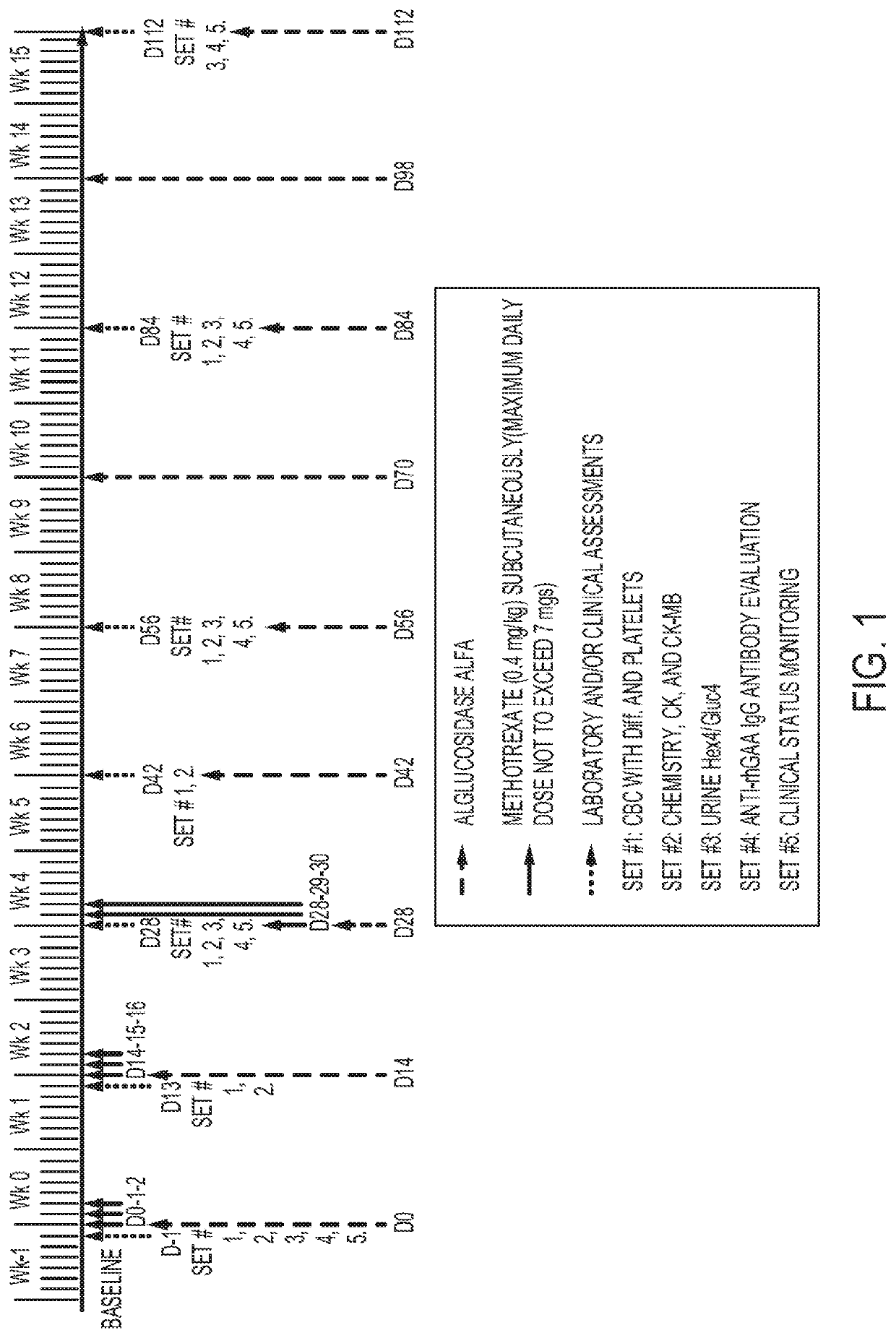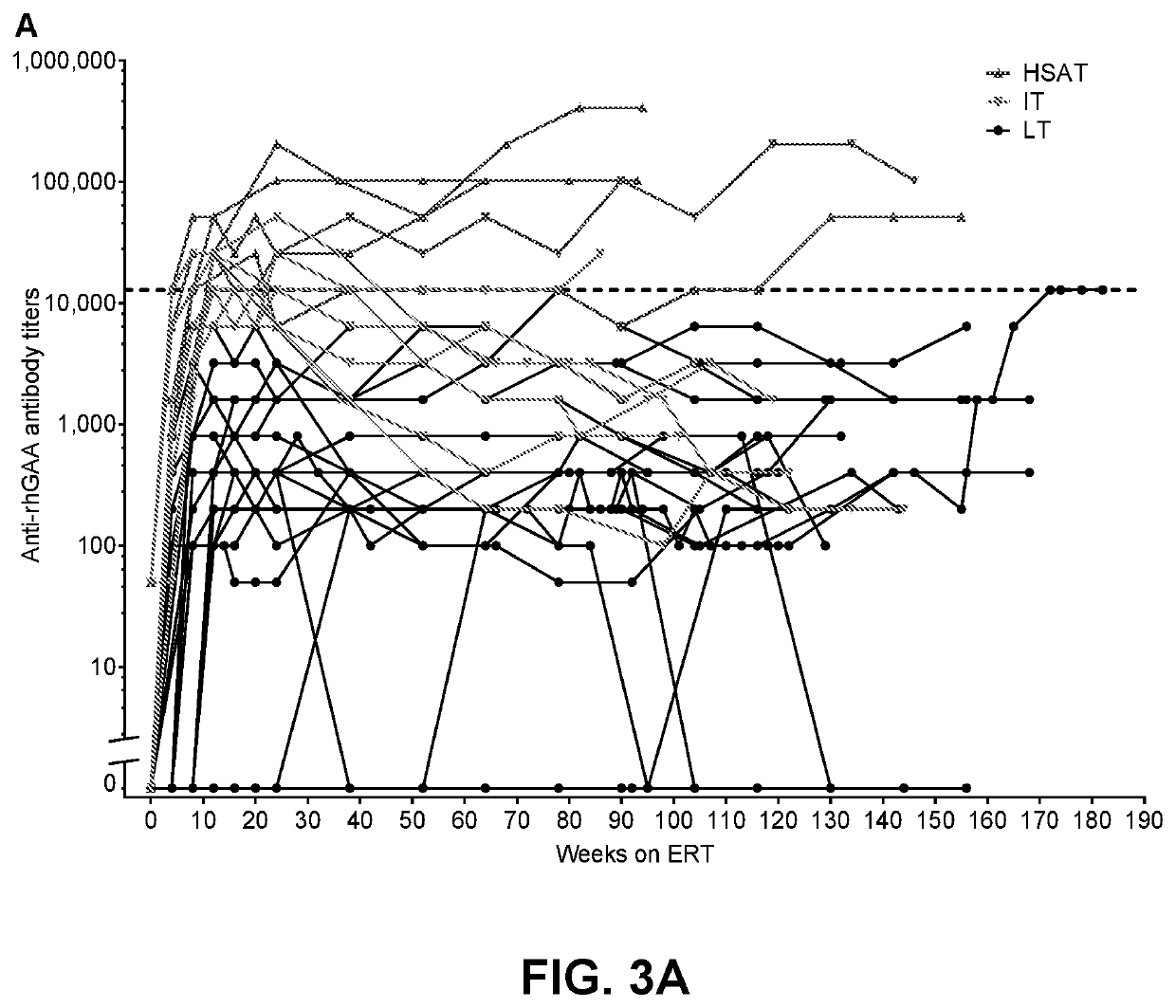Methods for the Use of Low-Dose Immune Modulators Transiently for Treating Patients Undergoing Protein Replacement Therapy
- Summary
- Abstract
- Description
- Claims
- Application Information
AI Technical Summary
Benefits of technology
Problems solved by technology
Method used
Image
Examples
example 1
ign to Investigate Immune Tolerance Induction (ITI) with Transient Low-Dose Methotrexate Co-Initiated with ERT Treatment in IOPD and LOPD Patients
[0079]To investigate immune tolerance induction (ITI) with transient low-dose methotrexate (TLD-MTX) co-initiated with recombinant human acid α-glucosidase (rhGAA), treatment-naïve cross-reactive immunologic material (CRIM)-positive infantile-onset Pompe disease (IOPD) patients were enrolled in a clinical study.
[0080]Patients and Inclusion and Exclusion Criteria
[0081]Patients with a confirmed diagnosis of IOPD (two confirmed GAA pathogenic variants) and a low GAA enzyme activity (in blood, muscle, or skin) who were CRIM-positive and ERT-naïve were enrolled in the study. CRIM status was determined by Western blot analysis and confirmed by GAA genotype or was predicted from GAA genotype alone.
[0082]Patients were classified as having classic infantile-onset Pompe disease (IOPD), atypical IOPD, or late-onset Pompe disease (LOPD). Classic IOPD ...
example 2
ults of ITI with Transient Low-Dose Methotrexate Co-Initiated with ERT Treatment in CRIM-Positive and CRIM-Negative IOPD and LOPD Patients
[0101]To investigate immune tolerance induction (ITI) with transient low-dose methotrexate (TLD-MTX) co-initiated with recombinant human acid α-glucosidase (rhGAA), a cohort of 17 newly-diagnoses, treatment-naïve cross-reactive CRIM-positive patients with Pompe disease were treated.
[0102]Patient Disposition
[0103]There were 17 CRIM-positive patients with Pompe disease, naïve to alglucosidase alfa, who received methotrexate ITI; 15 patients with IOPD (IOPD, n=10; atypical IOPD, n=5) and 2 patients with LOPD.
[0104]Longitudinal follow-up data of >6 months were available for 17 patients. Those with IOPD (n=10) had a follow-up range of 42-122 weeks, those with atypical IOPD (n=5) had a follow-up range of 58-145 weeks, and the 2 patients with LOPD had follow-up of 27 weeks and 63 weeks, respectively. Baseline demographics of the 17 patients with >6 month...
example 3
ults of ITI with Transient Low-Dose Methotrexate Co-Initiated with ERT Treatment in CRIM-Positive and CRIM-Negative IOPD Patients
[0117]To investigate immune tolerance induction (ITI) with transient low-dose methotrexate (TLD-MTX) co-initiated with recombinant human acid α-glucosidase (rhGAA), a cohort of 14 newly-diagnosed, treatment-naïve Pompe patients were treated.
[0118]Patient Disposition
[0119]The data reported above in Example 2 for patient IDs IOPD1-IOPD10, AIODP1 (referred to in Example 3 as IOPD11) and AIOPD5 (referred to in Example 3 as IOPD12) were combined and further analyzed with two additional Pompe patients, IOPD13 and IOPD14. Fourteen ERT-naïve patients with Pompe disease received prophylactic methotrexate ITI at the median age of 3.8 months (range, 0.7-13.5 months). Longitudinal follow-up data of >6 months were available for 14 patients with IOPD (13 CRIM-positive patients and 1 CRIM-negative patient). Of the 28 total GAA variants in the TLD-MTX group, 18 (64.3%), 3...
PUM
| Property | Measurement | Unit |
|---|---|---|
| Time | aaaaa | aaaaa |
| Dimensionless property | aaaaa | aaaaa |
| Dimensionless property | aaaaa | aaaaa |
Abstract
Description
Claims
Application Information
 Login to View More
Login to View More - Generate Ideas
- Intellectual Property
- Life Sciences
- Materials
- Tech Scout
- Unparalleled Data Quality
- Higher Quality Content
- 60% Fewer Hallucinations
Browse by: Latest US Patents, China's latest patents, Technical Efficacy Thesaurus, Application Domain, Technology Topic, Popular Technical Reports.
© 2025 PatSnap. All rights reserved.Legal|Privacy policy|Modern Slavery Act Transparency Statement|Sitemap|About US| Contact US: help@patsnap.com



